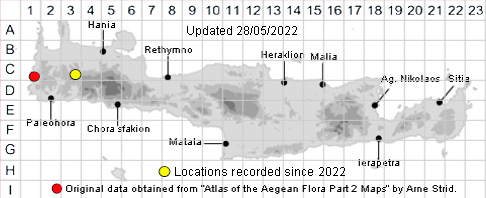
SPECIES DESCRIPTION
RANUNCULUS VERONICAE
Family and Genus:- See- RANUNCULACEAE
Common Names:- None
Homotypic Synonyms:- None
Meaning:- Ranunculus (L) Little-frog, diminutive of rana, (reference to the water-
loving habit of many species).
Veronicae (Gr) devoted to nomenclatural author's wife.
General description:- Delicate, very small and slender; whole plant sparsely
patent-pubescent.
Stems:-
1) 3-9 cm, simple or with one branching.
Leaves:-
1) Basal, comparatively large, ± orbicular, divided for 1/3-1/2 into obtuse, crenate,
overlapping lobes.
Flowers:-
1) Sepals, deflexed.
2) Petals, small and narrow 5.5-8 x 2.5-3 mm narrowly obovate, bright yellow. not
contiguous.
Fruit:-
1) Achenes;
a) head, broadly ovoid to subglobose.
b) body, strongly compressed, 2.5-3 mm, obliquely suborbicular, smooth and
glabrous, winged;
c) wing, confluent with a falcate or almost straight beak, 1-1.5 mm.
Key features:-
1) Blade, of the basal leaves divided for 1/3-1/2.
2) Petals, 5.5-8 narrowly obovate.
Habitat:- Damp crevices and stony soil pockets of schistose rocks under a canopy
of Platanus. 350-400 m. with Allium subhirsutum, Arisarum vulgare, Cyclamen
creticum, etc.
Distribution:- A rare local endemic discovered in 1998 by Niels Bohling, and
currently know from only one location in the extreme west.
Flowering time:- Mid-Mar - May
Photos by:- Fotis Samaritakis
